Memory Laps: Pool-time Recollections
Between the mid-1930s and 1960, only four swimming pool complexes in Singapore were open for public use. Jocelyn Lau speaks to people who remember these pools.
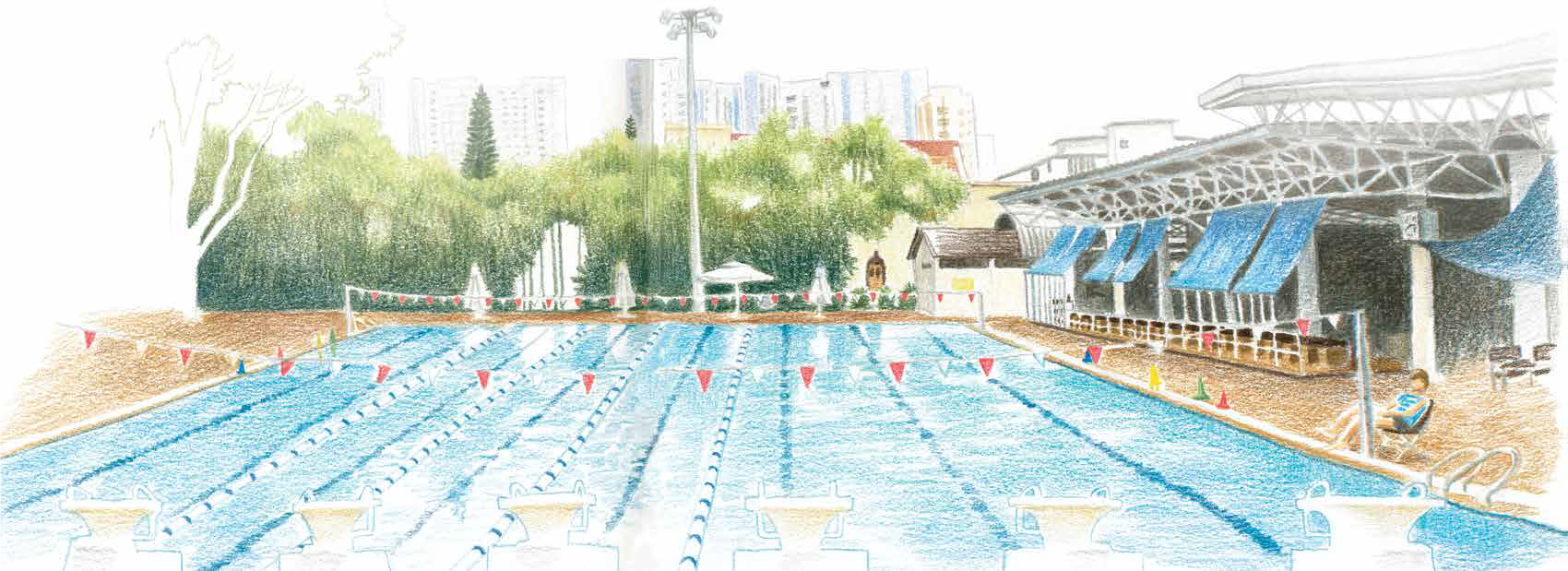 A drawing of the main pool at APS Swim School, managed by the former Olympian Ang Peng Siong. This was the former Farrer Park Swimming Complex until it closed in 2003. Farrer Park was the training ground for several of Singapore’s early swimming champions. Illustration by Favian Ee.
A drawing of the main pool at APS Swim School, managed by the former Olympian Ang Peng Siong. This was the former Farrer Park Swimming Complex until it closed in 2003. Farrer Park was the training ground for several of Singapore’s early swimming champions. Illustration by Favian Ee.The first public swimming complexes in Singapore – the four earliest in operation before 1960 – consistently drew capacity crowds from the time they were opened. In the mid-1930s, the number of bathers (as they were called then) at Mount Emily Swimming Complex reached a peak of 8,000 a month.
It was common to see standing-room-only space in the first swimming pools and, outside the complexes, people queuing patiently under the sun for hours in long, snaking lines. In the 1990s, however, the use of these pools declined sharply as residents moved to new neighbourhoods outside the city centre.
Singaporeans who are old enough to remember these pools continue to feel nostalgic about them and many were sad when they eventually closed. Of the four pools from this “pioneering” period, only Farrer Park Swimming Complex still stands today.
Mount Emily Swimming Complex
Location: Upper Wilkie Road
Open from: 10 Jan 1931 to 15 Dec 1981 (intermittently closed in the 1940s)
Singapore’s very first public swimming pool, Mount Emily Swimming Complex, was also the first public pool to use fresh water instead of seawater. At its peak in the mid-1930s, the pool saw some 8,000 visitors a month. After World War II, the pool underwent major repair works before it was reopened to the public. Mount Emily Swimming Complex was finally closed in 1981 and demolished the following year.
In the late 1880s, two service reservoirs, each with a holding capacity of one million gallons, were constructed on Mount Emily to supply the city with fresh water. One of these reservoirs was converted into a public swimming pool in 1931 when a 3-million-gallon storage reservoir at Fort Canning was opened in 1929. The other tank was used to store water for flushing drains and general cleansing of the town.
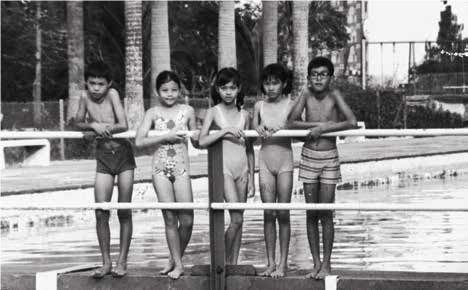 Children waiting for their swimming lesson to begin at Mount Emily Swimming Complex – Singapore’s first public pool – in the mid-1970s. The pool was converted from a service reservoir in 1931 and survived for just over five decades until it was closed down for good in 1981. Courtesy of Ng Yong Chiang.
Children waiting for their swimming lesson to begin at Mount Emily Swimming Complex – Singapore’s first public pool – in the mid-1970s. The pool was converted from a service reservoir in 1931 and survived for just over five decades until it was closed down for good in 1981. Courtesy of Ng Yong Chiang.Converting Mount Emily’s former service reservoir into a swimming pool meant reducing its depth from the original 15 feet to a maximum of 8 feet, and grading its floor. Earth was filled in to the required depth and concrete was then poured over it to form the floor. A vertical wall, built around the sloping sides of the tank, was perforated so that the weight of the water could also be supported by the original walls. The swimming pool consisted of a deep section for good swimmers and a shallow portion for beginners.
In the 1930s, the pool water was purified using chlorination, and water samples from the pool were tested weekly. About three years after World War II, before re-opening the pool for public use, the Singapore Municipal Commission installed a filtration system to keep the water clear and continued using chlorination to keep it clean for swimmers.
“I have fond memories of the Mount Emily pool. Between 1966 and 1969, I was a national swimmer and represented both the country and the Ministry of Home Affairs, where I first worked. For the former, our team trained six evenings a week at a private pool. I also trained at Mount Emily with the police swim team during the day, three times a week.”
“At the 1967 Southeast Asian Peninsular Games (SEAP) in Bangkok, my team took home two silver medals, one in the 4×200-metre freestyle relay, and the other in the 4×100-metre freestyle relay. Those were the years when Singapore’s first golden girl, Patricia Chan, was winning gold medals in every swimming event she entered in the SEAP Games, so it was great to be a part of the history-making.”
− Chan Kee Cheng, 73, former national swimmer
“When Singapore gained independence, one of the most pressing matters was to build a substantial military force for self defence. The National Service (NS) Amendment Act passed on 14 March 1967 made it compulsory for male citizens to register for NS. Together with the late pool superintendant Lee Hon Ming and a few other instructors, I helped to train about 600 recruits from the Singapore Police Force in lifesaving skills.”
“The course consisted of 12 sessions and was held three mornings each week, before the pool was opened for public use at 9am. It culminated in a qualifying test for the Bronze Medallion award from the Royal Life Saving Society UK. In addition to lifesaving training, Mount Emily was also the place where many potential national swimmers were trained for international competitions under the famous national swimming coach Kee Soon Bee.”
− Ong Poh Soon, 73, retired pool manager
Yan Kit Swimming Complex
Location: Yan Kit Road
Open from: 29 December 1952 to March 2001
Named after Look Yan Kit, a wealthy Canton-born dentist, Yan Kit Swimming Complex was originally a water tank built on an old railway site off Cantonment Road. Popular in the 1950s and 60s, the complex was closed in 2001 and the pools levelled over.
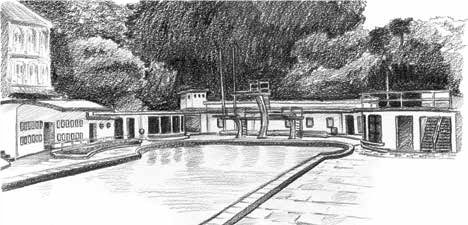 Floodlights were first introduced at Yan Kit Swimming Complex in 1954 to see if night-time swimming would prove popular – and it did. Entrance fees when the pool first opened cost 15 cents and users were restricted to a two-hour limit due to its popularity. Illustration by Favian Ee.
Floodlights were first introduced at Yan Kit Swimming Complex in 1954 to see if night-time swimming would prove popular – and it did. Entrance fees when the pool first opened cost 15 cents and users were restricted to a two-hour limit due to its popularity. Illustration by Favian Ee.Today, the site is being redeveloped as a community sports facility, which will include a multi-purpose playing court, a children’s playground and fitness zones.
“The Yan Kit Swimming Complex, tucked away in a leafy fold in the foothills of Tanjong Pagar, was the nicest and most unusual swimming pool I have ever swum in. It started life in the pre-war era as a water filtration tank for the municipal water supply, but was reconstituted, postwar, as a public swimming pool.”
“Architecturally, it was a superb piece of tropical Art Deco, all curved walls and portholes, flat roofs and ship’s railings, situated halfway between an ocean liner and a machine-gun emplacement. In England it would have been called The Lido. At one end there was a pavilion with a charming ‘marine mural’, featuring jellyfish and octopuses, while at the other end there were Deco-style diving boards, free-standing sculptures in reinforced concrete, looking for all the world like the rib-cage of a whale.”
“When it opened in the early 1950s, the Yan Kit pool was so popular that crowd controls had to be imposed, with a two-hour limit for each swimmer, and even then it was standing-room only. I used to go there for a lunchtime swim in the 1990s, when it was an all-but-forgotten oasis of calm and tranquillity, just a stone’s throw from the city. The pool attendants had the cushiest job ever, which is perhaps why they were also the friendliest of people, who used to amuse themselves by raising goldfish and water lilies in the footbaths.”
− Dr Julian Davison, architectural historian
 A panoramic view of the main pool at Yan Kit Swimming Complex, which opened in 1952 after an old water tank was renovated and converted into a swimming pool. Singapore’s second public pool was named after Look Yan Kit, a wealthy Canton-born dentist. The three springboards at the far end had heights of 1, 3 and 5 metres. Courtesy of Julian Davison.
A panoramic view of the main pool at Yan Kit Swimming Complex, which opened in 1952 after an old water tank was renovated and converted into a swimming pool. Singapore’s second public pool was named after Look Yan Kit, a wealthy Canton-born dentist. The three springboards at the far end had heights of 1, 3 and 5 metres. Courtesy of Julian Davison.Farrer Park Swimming Complex
Location: 2 Rutland Road
Open from: 22 February 1957 to 1 June 2003 (privatised in 2004)
The Farrer Park Swimming Complex was part of the Farrer Park Athletic Centre, which is significant for its association with high-profile regional sporting events in the 1960s and 70s, including the Southeast Asian Peninsular (SEAP) Games and Pesta Sukan. Closed in 2003, the complex is now managed privately by the APS Swim School, founded in 1995 by former Olympian Ang Peng Siong.
It was at this pool that the legendary coach Ang Teck Bee groomed his son Ang Peng Siong into one of the country’s best swimmers. The latter bagged 20 gold medals in eight Southeast Asian Games and was the record holder of the fastest 50-metre freestyle time in Asia between 1982 and 1996.
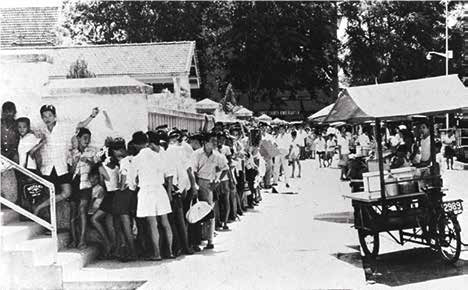 A long queue snaking outside Farrer Park Swimming Complex in the 1960s. The pool would become so crowded that on weekends, there was hardly space to swim a decent lap. Push-cart hawkers peddling food and drinks made a roaring business from users waiting to get in. Courtesy of SportSG.
A long queue snaking outside Farrer Park Swimming Complex in the 1960s. The pool would become so crowded that on weekends, there was hardly space to swim a decent lap. Push-cart hawkers peddling food and drinks made a roaring business from users waiting to get in. Courtesy of SportSG.“As a schoolgirl, I loved going to the swimming pool. The moment I got home from school, I’d drop my bag and then rush out again to Farrer Park to join my friends. I enjoyed stretching out my arms in front of me and doing simple flutter kicks. It was very relaxing. At one point, I went so often that my mum complained to my dad about it, and then he forbade me to go. I disobeyed, so I got into very big trouble when I finally went home again that evening! I dearly miss those carefree days.”
− Nellie Lee, 71, retired technician
“In the late 1960s, there were only a few public pools, so it was not surprising to find each one filled to, or beyond, capacity. In those days, one could hardly actually swim, as the pools were just too crowded.”
“When I was about 10, I visited Farrer Park on weekends with my father and some neighbours. We usually had to queue for one or two hours, and even then we might not be allowed entry. Sometimes, we’d see people scaling the walls to try to get in, even though there were glass bits embedded in the tops of the walls. Some of them were caught, and the lifeguards would walk the culprits around the pool before sending them out. In those days, it was also common to lose one’s belongings, and a friend once lost even his clothes. Fortunately, my father was able to give him a ride home in his car!”
− Donald Goh, 59, pharmaceutical executive
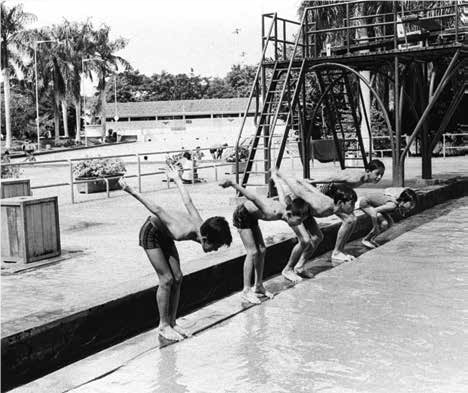 Students from Dorset School taking the leap at Farrer Park Swimming Complex in 1971. The pool complex opened in 1957 as part of Farrer Park Athletic Centre, which hosted regional sporting events such as the Southeast Asian Peninsular Games and Pesta Sukan in the 1960s and 70s. Dorset School Collection, courtesy of National Archives of Singapore.
Students from Dorset School taking the leap at Farrer Park Swimming Complex in 1971. The pool complex opened in 1957 as part of Farrer Park Athletic Centre, which hosted regional sporting events such as the Southeast Asian Peninsular Games and Pesta Sukan in the 1960s and 70s. Dorset School Collection, courtesy of National Archives of Singapore.River Valley Swimming Complex
Location: 74 River Valley Road
Open from: 29 August 1959 to 15 April 2003
Located at the former King George V Park, the River Valley Swimming Complex was designed by M.E. Crocker, the same British architect for Farrer Park. The swimming pool was extremely popular until the 1970s, when new estates were built away from the city centre and visitorship dwindled. It eventually closed in 2003. The site, renamed The Foothills Fort Canning Park, is currently home to art spaces and cafes.
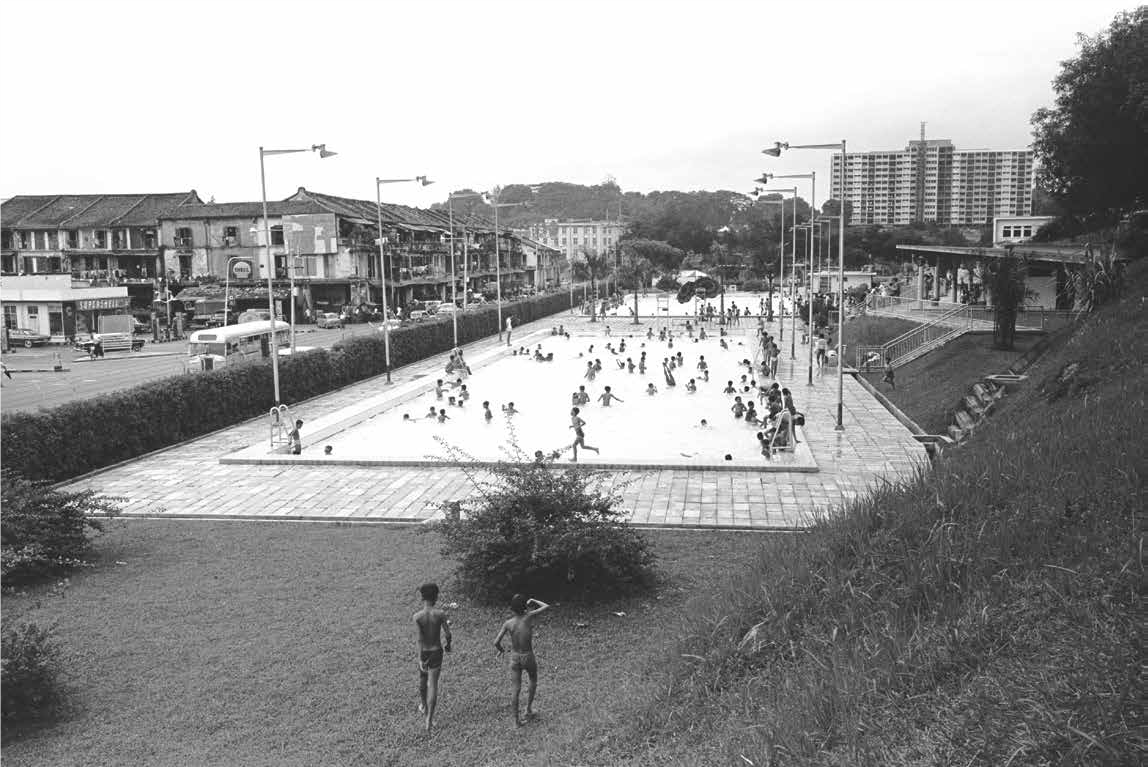 The swimming pool at River Valley Swimming Complex in 1963. In the first few weeks of the pool’s opening in 1959, it was reported that “tens of thousands of children” visited. The pool was extremely popular until the 1970s, when new estates were built away from the city centre and visitorship dwindled. Ministry of Information and the Arts Collection, courtesy of National Archives of Singapore.
The swimming pool at River Valley Swimming Complex in 1963. In the first few weeks of the pool’s opening in 1959, it was reported that “tens of thousands of children” visited. The pool was extremely popular until the 1970s, when new estates were built away from the city centre and visitorship dwindled. Ministry of Information and the Arts Collection, courtesy of National Archives of Singapore.“The foot of the southern slope of the ‘forbidden hill’ – Fort Canning Hill – seemed an unlikely location for a public swimming pool, even back in the 1970s when I first used it for physical education (PE) lessons. Getting to the River Valley pool from my secondary school, St Joseph’s Institution on Bras Basah Road, was always an adventure: the long walk required the better part of a double period (about an hour-long) PE lesson. However, we looked forward to it not just as an escape from classroom boredom, but also for the reward that came at the end of it: a dip in the pool. During the walks, we often chanced upon clandestine acts taking place in quiet corners and we found fun in making catcalls at the couples.”
“There was a diving platform at one end of the deep pool, and a smaller pool at the far end. The changing rooms were located on a terraced upslope. The exit from the pool was through an old turnstile typical of the older pools. Other than our class of boys, there would hardly be a soul on the premises, especially in mid-afternoon… It was with more than a tinge of sadness that I read about the demolishment of not only the pool complex, but also the adjacent landmarks of my teenage years – the National Theatre in 1986 and Van Kleef Aquarium in 1998.″
− Jerome Lim, 52, naval architect
“I worked at River Valley in the years when Singapore was still a part of Malaysia. The father of the late Lee Kuan Yew used to come to the pool in the evenings, alone, to swim. He didn’t tell anyone he was the prime minister’s father. Some people said he would park his car in front of the Beach Road police station and walk to the pool. Sometimes, after my late colleague Lee Sim Cheng and I closed the pool for the day, we would accompany the senior Mr Lee to have supper at the famous Hong Lim open-air hawker centre nearby, next to the old Tongji hospital. Those were the good old days… When Singapore became independent, I was transferred to Mount Emily Swimming Complex to help train recruits from the Singapore Police Force in lifesaving skills.”
− Ong Poh Soon, 73, retired pool manager
“My mother told me that her dad used to take her to the River Valley pool when she was small. My mother wanted to learn how to swim, but her father told her to watch the other children. My mother said she was really afraid that the crocodiles from the [Van Kleef] aquarium next door would escape and enter the pool. After my mother’s brother was born, my grandfather took him to swim too. One time, Mingming Jiujiu [uncle] walked, walked and walked down the pool steps and did not stop even when his head went underwater, and my grandfather had to pull him out.”
− Giam Kia Woon, 7, student
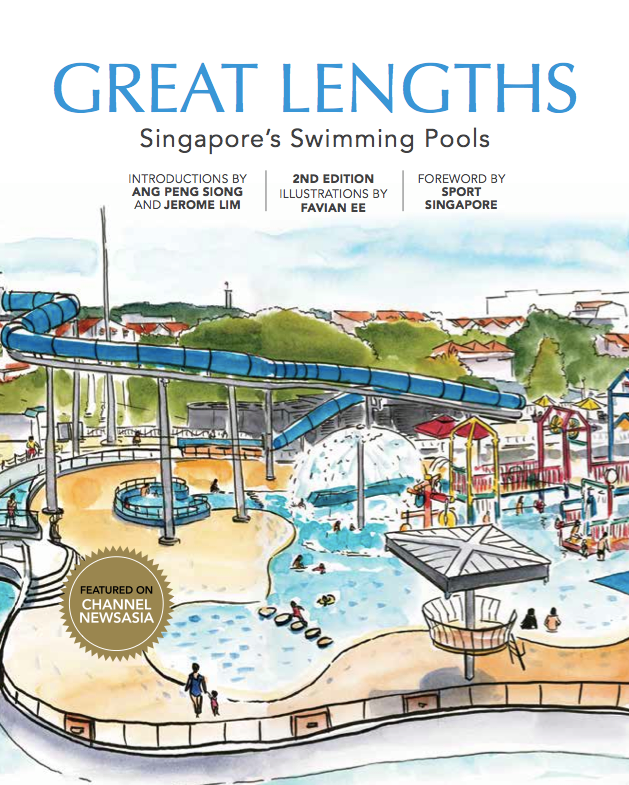
This is an extract from Great Lengths: Singapore’s Swimming Pools (2017) published by Kucinta Books. It retails for S$28 at major bookshops and is also available for reference and loan at the Lee Kong Chian Reference Library and selected public libraries (Call nos.: RSING 797.20095957 GRE and SING 797.20095957 GRE).
 Jocelyn Lau is a an editor and a writer with postgraduate qualifications in publishing. She is the co-publisher of Kucinta Books.
Jocelyn Lau is a an editor and a writer with postgraduate qualifications in publishing. She is the co-publisher of Kucinta Books.

